Tourism Information Diffusion through SNSs: A Theoretical Investigation
Abstract
1. Introduction
- evaluating SNSs’ efficacy in tourism destination promotion quantitatively, and;
- the mechanisms for sharing tourism information through SNS platforms from a holistic and systematic point of view [16].
- Develop a theoretical framework for defining TIDE, its components and the components’ interrelationships;
- Conduct social network connectivity analyses, including average degree, shortest path, and network centralisation, due to information diffusion processes;
- Evaluate the factors affecting visiting action to tourist destinations as a result of SNS users’ information diffusion.
2. Literature Review
2.1. Tourism Planning and Chinese Visitor Behaviour
2.2. Business Ecosystems
2.3. Diarising Travel in Social Media
2.4. Information Diffusion in Tourism Research
- (1)
- The influence of network structures. Examining a network structure is vital for understanding information diffusion, which determines the function of the network system and quality of information flow between network nodes. Baggio and Cooper [8] investigated the effect of a network structure on knowledge communication and transfer along a destination network using epidemic diffusion models. They found that a fragmented network may lead to a low capacity of a destination in absorbing knowledge and low speed of knowledge diffusion along a network. Therefore, in order to make a destination competitive, it is beneficial to form clusters of stakeholders. In 2014, Baggio later found links between a structured network and a tourism destination [11];
- (2)
- The influence of nodes on a network. Individuals play different roles in distributing information along a social network. Yang and Leskovec [43] developed a linear influence model to predict how nodes influence each other and found that nodes (here, Twitter users) with the highest number of followers do not necessarily have the highest influence. The influence of individual nodes depends on the type of node and information. To date, there has been limited research done to understand the roles played by individuals in information diffusion along tourism social networks;
- (3)
- Dynamic process or diffusion mechanism. The essential Vickrey–Clarke–Groves mechanism theory explores incentivising information diffusion through accurate social interaction to achieve socially-optimal outcomes and how information spreads along social networks [44]. It is used in ICT, linguistics, psychology, mathematics, statistics and tourism. Goffman’s epidemic model [45] replicates infection between individuals, gradually diffusing, dispersing, losing its potency and eventually disappearing. A web forum’s information diffusion provides an understanding of the forces behind the diffusion of ideas and is predictive. Epidemic-like, interest wanes and ends as the topic popularity loses interest within a web forum of dialogue. Four types of spatial diffusion processes were defined by Gould [46]: relocation diffusion, expansion diffusion, contagious diffusion and hierarchical diffusion. Although they were developed for spatial diffusion, they can be used for defining information diffusion.
2.5. Information Diffusion, Online Review Helpfulness and Visiting Action Behaviour
2.6. System Theory and Tourism
3. TIDE’s Theoretical Framework
3.1. Theoretical Foundation of TIDE
- social and political interactions between origins and destinations;
- push factors driving tourists away from destinations, such as host counties’ unemployment, a lack of services and amenities, epidemics, natural disasters or poverty;
- pull factors attracting tourists, such as potential employment opportunities, unique scenery, attractive climate, and communication technologies connecting people and places.
- Influencers: trip diarists who have visited a destination and posted their experience and comments into their trip diaries. They may influence several types of followers;
- Close followers: those who post comments and who have also visited the same destinations and post a trip diary of their own experience;
- Loose followers: those who post comments without providing evidence of visiting a destination;
- Emotion sharers: those who have travelled before reading any trip diary and then comment in a trip diary of their choice but not their own. They hold less persuasive inducement than the influencers.
3.2. Definition of TIDE
3.2.1. Structure
- Hierarchical structure: arranged by destination, styled on the real-world, or top-down categorisation for easy searching, of geographical location using continent, country, state, city, town, tourism attraction;
- Flat structure: a horizontally styled organisation of parallels, maintaining flexibility, organised by an individual or forum participant. Itncludes personal information, blogs, travel itineraries, destination information, local modes of travel, accommodation, restaurants and tourist attractions, and other related activities.
- Ring network: passing from one participant to another, forming a circle;
- Tree network: passing from influencers to close followers, while close followers become influencers and pass trip diary information to other close followers to forming a tree-like structure;
- Star network: passing from influencers (hubs) to loose followers (spokes). The loose followers might not keep in contact;
- Mesh network: well-connected, communicative network, passing freely from or between influencers, close followers, loose followers and emotion sharers;
- Loosely connected network: passing intermittently from influencers, loose followers, and emotion sharers, with individual or pairs of users existing without communicating with others;
- Hybrid network: a combination of the above.
3.2.2. Processes of TIDE
Expansion Diffusion
Contagious Diffusion
3.2.3. Functions of TIDE
Information and Emotion Sharing (Self-Realisation and Self-Esteem of Travellers)
Travel Community-Interconnection and Integration of Places, Information, Travellers and Tourism Industries
Adaptation to the Environment (Dynamic Process)
3.2.4. Outcomes of TIDE
- Economic: increased exposure to tourist information through SNSs, which leads to potential tourism and encourage spending at a tourist destination;
- Social: effective channels to make new friends internationally, encourage tourists’ positive feelings and attitudes and lift travel experiences to endure through recall and memories and recollect tourism memories;
- Cultural value: better knowledge of the culture and expectations of the destination and its communities. A destination that satisfies tourists is well-recommended by the tourists though pictures, description, comments and feedback of the destination on SNSs, which defines the destination’s image and influences other tourists’ purchasing decisions [60].
4. Methodology
4.1. Study Area
4.2. Data Collection Methods
4.3. Tourism Information Diffusion Network Analysis
4.4. Modelling: Zero-Inflated Poisson (Zip) Model for Predicting Visiting Actions to Tourist Destinations Due to Tourism Information Diffusion
- Influencer’s accumulative efforts devoted to the SNS, such as time, the number of information diffusion posted, the number of times answering other people’s questions on SNSs, quantified as rank;
- Number of followers of the influencer who will view the influencer’s trip diary first, marked as fans;
- Number of words included in the trip diaries, marked as word;
- Number of pictures included in the trip diaries, marked as picture;
- Times of the trip diaries viewed, marked as view;
- Times of the trip diaries saved, marked as save;
- Times of the trip diary was placed on the top by SNS users, marked as placing on the top;
- Times of the trip diaries shared, marked as share;
- Duration since trip diaries first posted until 12 September 2017, marked as duration.
5. Results
5.1. The Characteristics of the Information Diffusion Networks
5.2. The Structure of Their Information Diffusion Network
5.3. Information Diffusion Process for Close Followers
5.4. ZIP Regression Model of Visiting Action to Tourist Destinations
6. Discussion and Conclusions: The Implication of TIDE and Its Future Uses
Author Contributions
Funding
Acknowledgments
Conflicts of Interest
References
- Leung, D.; Law, R.; van Hoof, H.; Buhalis, D. Social Media in Tourism and Hospitality: A Literature Review. J. Travel Tour. Mark. 2013, 30, 3–22. [Google Scholar] [CrossRef]
- Kim, H.; Xiang, Z.; Fesenmaier, D.R. Use of The Internet for Trip Planning: A Generational Analysis. J. Travel Tour. Mark. 2015, 32, 276–289. [Google Scholar] [CrossRef]
- Hlee, S.; Cheng, A.; Koo, C.; Kim, T. The difference of information diffusion for Seoul tourism destination according to user certification on Sina Weibo: Through data crawling method. Int. J. Tour. Sci. 2017, 17, 262–275. [Google Scholar] [CrossRef]
- Chua, M.W.J. Diffusion of Travel Information through Innovation: A Social Network Analysis; The University of Queensland: Brisbane, Australia, 2012. [Google Scholar]
- Baggio, R.; Del Chiappa, G. Real and virtual relationships in tourism digital ecosystems. Inf. Technol. Tour. 2014, 14, 3–19. [Google Scholar] [CrossRef]
- Miguéns, J.; Baggio, R.; Costa, C. Social media and tourism destinations: TripAdvisor case study. Adv. Tour. Res. 2008, 26, 1–6. [Google Scholar]
- Dhaigude, A.S.; Kapoor, R.; Ambekar, S. A conceptual model for adoption of information communication technology in the travel and tourism industry. Tour. Recreat. Res. 2016, 41, 49–59. [Google Scholar] [CrossRef]
- Baggio, R.; Cooper, C. Knowledge transfer in a tourism destination: The effects of a network structure. Serv. Ind. J. 2010, 30, 1757–1771. [Google Scholar] [CrossRef]
- Baggio, R. Collaboration and cooperation in a tourism destination: A network science approach. Curr. Issues Tour. 2011, 14, 183–189. [Google Scholar] [CrossRef]
- Beritelli, P. Cooperation among prominent actors in a tourist destination. Ann. Tour. Res. 2011, 38, 607–629. [Google Scholar] [CrossRef]
- Baggio, R. Creativity and the Structure of Tourism Destination Networks. Int. J. Tour. Sci. 2014, 14, 137–154. [Google Scholar] [CrossRef]
- Hsiao, J.P.-H.; Jaw, C.; Huan, T.-C. Information diffusion and new product consumption: A bass model application to tourism facility management. J. Bus. Res. 2009, 62, 690–697. [Google Scholar] [CrossRef]
- González, S. Bilbao and Barcelona ‘in motion’. How urban regeneration ‘models’ travel and mutate in the global flows of policy tourism. Urban Stud. 2011, 48, 1397–1418. [Google Scholar] [CrossRef]
- Racherla, P.; Hu, C. A social network perspective of tourism research collaborations. Ann. Tour. Res. 2010, 37, 1012–1034. [Google Scholar] [CrossRef]
- Bakshy, E.; Rosenn, I.; Marlow, C.; Adamic, L. The role of social networks in information diffusion. In Proceedings of the 21st International Conference on World Wide Web, Lyon, France, 16–20 Apirl 2012; ACM: New York, NY, USA, 2012; pp. 519–528. [Google Scholar]
- Baggio, R.; Scott, N.; Cooper, C. Improving tourism destination governance: A complexity science approach. Tour. Rev. 2010, 65, 51–60. [Google Scholar] [CrossRef]
- Leiper, N. Tourist attraction systems. Ann. Tour. Res. 1990, 17, 367–384. [Google Scholar] [CrossRef]
- Iansiti, M.; Levien, R. The Keystone Advantage: What the New Dynamics of Business Ecosystems Mean for Strategy, Innovation, and Sustainability; Harvard Business Press: Boston, MA, USA, 2004. [Google Scholar]
- Von Bertalanffy, L. General System Theory; Penguin, Braziller: Middlesex, UK, 1968. [Google Scholar]
- Xia, J.C.; Adriano, R.; Prude Carcausto Zea, Z.; Crowe-Delaney, L.; Liu, Y.; Holmes, K.; Chen, Z. Are We China-Ready? Chinese Tourism in Western Australia. 2018. Available online: https://bcec.edu.au/publications/are-we-china-ready/ (accessed on 16 December 2019).
- Crowe-Delaney, L. Queensland-Gold Coast tourism, the Japanese era 1980–1997 and single market strategies-a case study. In Ethical and Responsible Tourism: Managing Sustainability in Local Tourism Destinations; CRC Press, Taylor Francis, Routledge Earthscan: Boca Raton, FL, USA, 2019. [Google Scholar]
- Xiang, Z.; Fesenmaier, D.R. Big data analytics, tourism design and smart tourism. In Analytics in Smart Tourism Design; Springer: Berlin/Heidelberg, Germany, 2017; pp. 299–307. [Google Scholar]
- Hall, C.M. Framing behavioural approaches to understanding and governing sustainable tourism consumption: Beyond neoliberalism, “nudging” and “green growth”? J. Sustain. Tour. 2013, 21, 1091–1109. [Google Scholar] [CrossRef]
- Saarinen, J.; Rogerson, C.M.; Hall, C.M. Geographies of Tourism Development and Planning; Taylor & Francis: Abingdon, UK, 2017. [Google Scholar]
- Hall, C.M. Tourism and Social Marketing; Routledge: Abingdon, UK, 2014. [Google Scholar]
- Tourism Western Australia. Domestic Visitation Fast Facts-September 2017; Government of Western Australia: Perth, Australia, 2017. [Google Scholar]
- Tourism Western Australia. International Visitation Fast Facts-September 2017. T. W. Australia; Government of Western Australia: Perth, Australia, 2017. [Google Scholar]
- Sigala, M.; Gretzel, U. Advances in Social Media for Travel, Tourism and Hospitality: New Perspectives, Practice and Cases; Routledge: Abingdon, UK, 2017. [Google Scholar]
- Zhou, N. Beautiful one day, pitiful the next: Is ‘philausophy’ a new low for Australian tourism ads? In The Guardian; Guardian News & Media Limited; Available online: https://www.theguardian.com/media/2019/oct/30/australia-latest-tourism-ad-have-we-reached-a-new-low-philausophy (accessed on 10 January 2020).
- Kasabov, E.; Peng, Y. Understanding e-Word of Mouth at Chinese Social Networking Sites. In Marketing Challenges in a Turbulent Business Environment; Springer: Berlin/Heidelberg, Germany, 2016; pp. 691–692. [Google Scholar]
- Greeven, M.J.; Wei, W. Business Ecosystems in China: Alibaba and Competing Baidu, Tencent, Xiaomi and LeEco; Routledge: Abingdon, UK, 2017. [Google Scholar]
- Tuan, Y.-F. Space and Place: The Perspective of Experience; University of Minnesota Press: Minneapolis, MN, USA, 1977. [Google Scholar]
- Jing, G.; Gretzel, U. A new cultural revolution Chinese consumers’ internet and social media use. In Advances in Social Media for Travel, Tourism and Hospitality; Sigala, M., Gretzel, U., Eds.; Routledge: London, UK, 2018. [Google Scholar]
- Choe, Y.; Kim, J.; Fesenmaier, D.R. Use of social media across the trip experience: An application of latent transition analysis. J. Travel Tour. Mark. 2017, 34, 431–443. [Google Scholar] [CrossRef]
- Yoo, K.-H.; Gretzel, U. Influence of personality on travel-related consumer-generated media creation. Comput. Hum. Behav. 2011, 27, 609–621. [Google Scholar] [CrossRef]
- Shao, G. Understanding the appeal of user-generated media: A uses and gratification perspective. Internet Res. 2009, 19, 7–25. [Google Scholar] [CrossRef]
- MacCannell, D. Tourist agency. Tour. Stud. 2001, 1, 23–37. [Google Scholar] [CrossRef]
- Munar, A.M.; Jacobsen, J.K.S. Motivations for sharing tourism experiences through social media. Tour. Manag. 2014, 43, 46–54. [Google Scholar] [CrossRef]
- Crowe-Delaney, L. Deconstructing the staged and existential authentic of rurality in Japan. Int. J. Tour. Anthropol. 2018, 6, 255–275. [Google Scholar] [CrossRef]
- Jalilvand, M.R.; Samiei, N. The impact of electronic word of mouth on a tourism destination choice: Testing the theory of planned behavior (TPB). Internet Res. Electron. Netw. Appl. Policy 2012, 22, 591–612. [Google Scholar] [CrossRef]
- Bosangit, C.; Dulnuan, J.; Mena, M. Using travel blogs to examine the postconsumption behavior of tourists. J. Vacat. Mark. 2012, 18, 207–219. [Google Scholar] [CrossRef]
- Yang, J.; Leskovec, J. Modeling information diffusion in implicit networks, Data Mining (ICDM). In Proceedings of the 2010 IEEE 10th International Conference on Data Mining, Sydney, Australia, 13–17 December 2010; pp. 599–608. [Google Scholar]
- Green, J.R.; Laffont, J.-J. Incentives in Public Decision Making; Elsevier North-Holland: Amsterdam, The Netherlands, 1979. [Google Scholar]
- Woo, J.; Chen, H. Epidemic model for information diffusion in web forums: Experiments in marketing exchange and political dialog. SpringerPlus 2016, 5, 1–19. [Google Scholar] [CrossRef]
- Gould, P.R. Spatial Diffusion, Resource Paper No. 4; Association of American Geographers: Washington, DC, USA, 1969. [Google Scholar]
- Song, H.; Li, G. Tourism demand modelling and forecasting-A review of recent research. Tour. Manag. 2008, 29, 203–220. [Google Scholar] [CrossRef]
- Zhang, Z.; Ye, Q.; Law, R.; Li, Y. The impact of e-word-of-mouth on the online popularity of restaurants: A comparison of consumer reviews and editor reviews. Int. J. Hosp. Manag. 2010, 29, 694–700. [Google Scholar] [CrossRef]
- Huang, A.H.; Chen, K.; Yen, D.C.; Tran, T.P. A study of factors that contribute to online review helpfulness. Comput. Hum. Behav. 2015, 48, 17–27. [Google Scholar] [CrossRef]
- Qazi, A.; Syed, K.B.S.; Raj, R.G.; Cambria, E.; Tahir, M.; Alghazzawi, D. A concept-level approach to the analysis of online review helpfulness. Comput. Hum. Behav. 2016, 58, 75–81. [Google Scholar] [CrossRef]
- Butler, R.W. The concept of a tourist area cycle of evolution: Implications for management of resources. Can. Geogr. Le Géographe Canadien 1980, 24, 5–12. [Google Scholar] [CrossRef]
- Baggio, R.; Scott, N.; Cooper, C. Network science: A Review Focused on Tourism. Ann. Tour. Res. 2010, 37, 802–827. [Google Scholar] [CrossRef]
- Leiper, N. The framework of tourism: Towards a definition of tourism, tourist, and the tourist industry. Ann. Tour. Res. 1979, 6, 390–407. [Google Scholar] [CrossRef]
- Faulkner, B.; Russell, R. Chaos and complexity in tourism: In search of a new perspective. Pac. Tour. Rev. 1997, 1, 93–102. [Google Scholar]
- Sheng, L. Regional competition and sustainable development: A game theory model for tourism destinations. Eur. Plan. Stud. 2011, 19, 669–681. [Google Scholar] [CrossRef]
- Baggio, R. Symptoms of complexity in a tourism system. Tour. Anal. 2008, 13, 1–20. [Google Scholar] [CrossRef]
- Dickinger, A.; Lalicic, L. Tourist driven innovations in social media. In Advances in Social Media for Travel, Tourism and Hospitality: New Perspectives Practice and Cases; Sigala, M., Gretzel, U., Eds.; Routledge: London, UK, 2017. [Google Scholar]
- Naimzada, A.K. Networks, Topology and Dynamics: Theory and Applications to Economics and Social Systems; Naimzada, A.K., Stefani, S., Torriero, A., Eds.; Springer: Berlin/Heidelberg, Germany, 2009. [Google Scholar]
- Liu, H.; Wu, L.; Li, X. Social Media Envy: How Experience Sharing on Social Networking Sites Drives Millennials’ Aspirational Tourism Consumption. J. Travel Res. 2018, 58, 355–369. [Google Scholar] [CrossRef]
- McWha, M.; Frost, W.; Laing, J. Travel writers and the nature of self: Essentialism, transformation and (online) construction. Ann. Tour. Res. 2018, 70, 14–24. [Google Scholar] [CrossRef]
- Pardo-García, C.; Coll-Serrano, V.; Rausell-Köster, P.; Pérez Bustamante-Yábar, D. Cultural attitudes and tourist destination prescription. Ann. Tour. Res. 2018, 71, 59–61. [Google Scholar] [CrossRef]
- Wang, Y.; Davidson, M. Pre- and Post-Trip Perceptions: An Insight into Chinese Package Holiday Market to Australia. J. Vacat. Mark. 2010, 16, 111–123. [Google Scholar] [CrossRef]
- Population Australia. Population of Western Australia 2020. Available online: http://www.population.net.au/population-of-western-australia/ (accessed on 10 January 2020).
- ABS, Australian Bureau of Statistics. W.A. 2017. Available online: http://stat.abs.gov.au/itt/r.jsp?databyregion (accessed on 18 August 2019).
- Tourism WA. Domestic Visitation-Fast Facts-Year Ending September 2018; Tourism WA-Strategy and Research: Perth, Australia, 2018; p. 11. [Google Scholar]
- Tourism WA. International Visitation-Fast Facts-Year Ending September 2018; Tourism WA-Strategy and Research: Perth, Australia, 2018; p. 11. [Google Scholar]
- Pilat, L. WA Government’s Million Dollar Plan to Attract More Chinese Tourists. WAtoday. 2018. Available online: https://www.watoday.com.au/national/western-australia/wa-government-s-million-dollar-plan-to-attract-more-chinese-tourists-20181111-p50fe5.html (accessed on 10 January 2020).
- Freeman, L.C. Centrality in social networks conceptual clarification. Soc. Netw. 1978, 1, 215–239. [Google Scholar] [CrossRef]
- Lambert, D. Zero-Inflated Poisson Regression, with an Application to Defects in Manufacturing. Technometrics 1992, 34, 1–14. [Google Scholar] [CrossRef]
- Lee, Y.-G.; Lee, J.-D.; Song, Y.-I.; Lee, S.-J. An in-depth empirical analysis of patent citation counts using zero-inflated count data model: The case of KIST. Scientometrics 2007, 70, 27–39. [Google Scholar] [CrossRef]
- Plotnikova, T.; Rake, B. Collaboration in Pharmaceutical Research: Exploration of Country-Level Determinants; Springer-Verlag: Berlin/Heidelberg, Germany, 2014; Volume 98, pp. 1173–1202. [Google Scholar]
- Sidone, O.J.G.; Haddad, E.A.; Mena-Chalco, J.P. Scholarly publication and collaboration in Brazil: The role of geography. J. Assoc. Inf. Sci. Technol. 2017, 68, 243–258. [Google Scholar] [CrossRef]
- Long, J.S. Regression Models for Categorical and Limited Dependent Variables. In A Handbook of Statistical Analyses Using R; Everitt, B.S., Hothorn, T., Eds.; Sage Publications: Thousand Oaks, CA, USA, 1997. [Google Scholar]
- Zeileis, A.; Kleiber, C.; Jackman, S. Regression models for count data in R. J. Stat. Softw. 2008, 27, 1–25. [Google Scholar] [CrossRef]
- Borgatti, S.P.; Everett, M.G.; Freeman, L.C. Ucinet for Windows: Software for Social Network Analysis; Analytic Technologies: Harvard, MA, USA, 2002. [Google Scholar]
- Ziv, N.D.; White, K.-A. Social Bookmarking on a Company’s Intranet: A Study of Technology Adoption and Diffusion. In Handbook of Social Network Technologies and Applications; Furht, B., Ed.; Springer US: Boston, MA, USA, 2010; pp. 691–711. [Google Scholar]
- Schmallegger, D.; Carson, D. Blogs in tourism: Changing approaches to information exchange. J. Vacat. Mark. 2008, 14, 99–110. [Google Scholar] [CrossRef]
- Cha, M.; Kwak, H.; Rodriguez, P.; Ahn, Y.-Y.; Moon, S. Analyzing the video popularity characteristics of large-scale user generated content systems. IEEE/ACM Trans. Netw. 2009, 17, 1357–1370. [Google Scholar]
- Chinese Tourism Academy. Annual Report of China Inbound Tourism Development 2013; Chinese Tourism Academy: Beijing, China, 2013. [Google Scholar]
- Chinese Tourism Academy. Annual Report of China Inbound Tourism Development 2014; Chinese Tourism Academy: Beijing, China, 2014. [Google Scholar]
- Shirky, C. Here Comes Everybody: The Power of Organizing without Organizations; Penguin Press: New York, NY, USA, 2008. [Google Scholar]
- Wang, Y.; Fesenmaier, D.R. Towards understanding members’ general participation in and active contribution to an online travel community. Tour. Manag. 2004, 25, 709–722. [Google Scholar] [CrossRef]
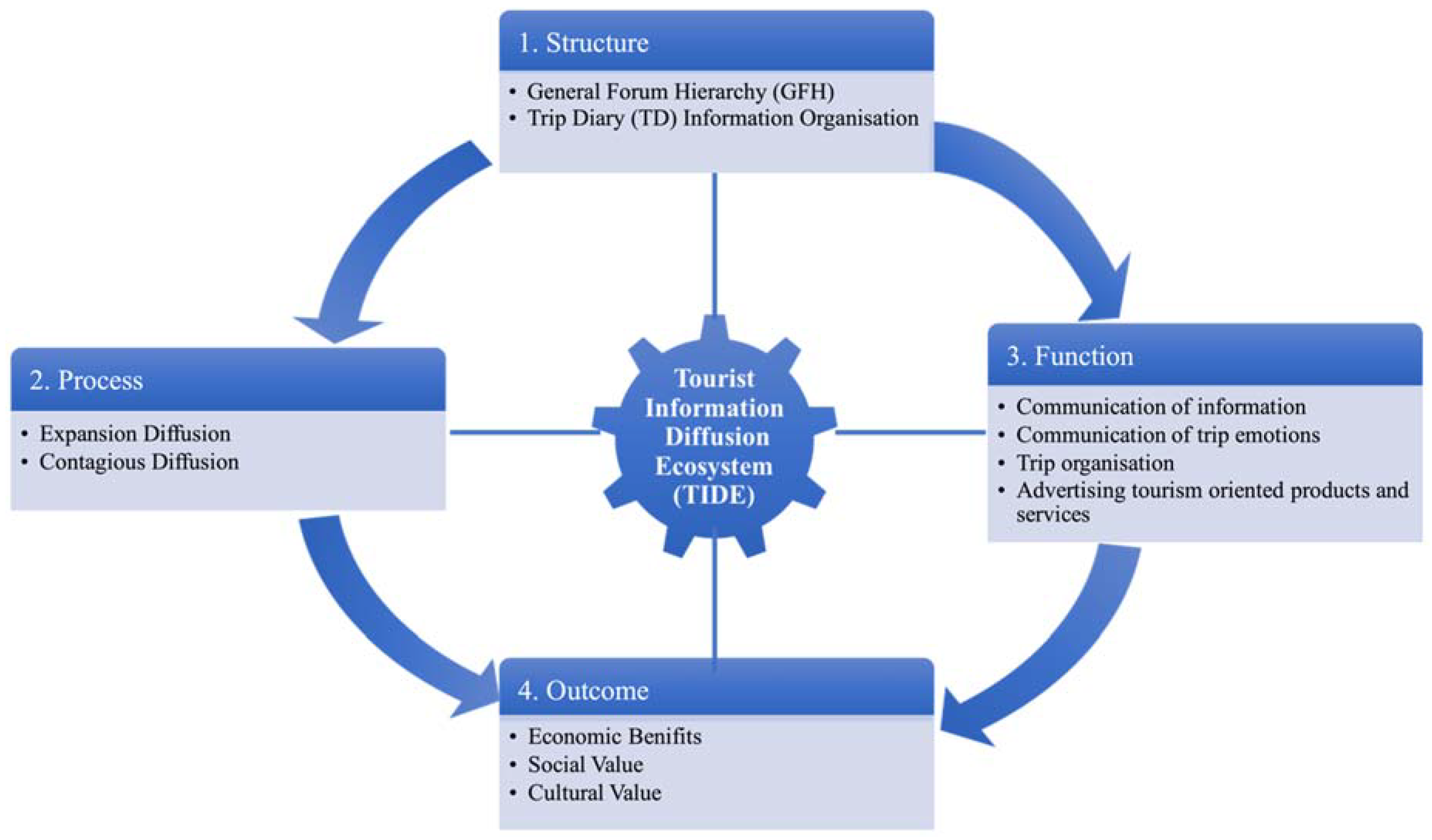
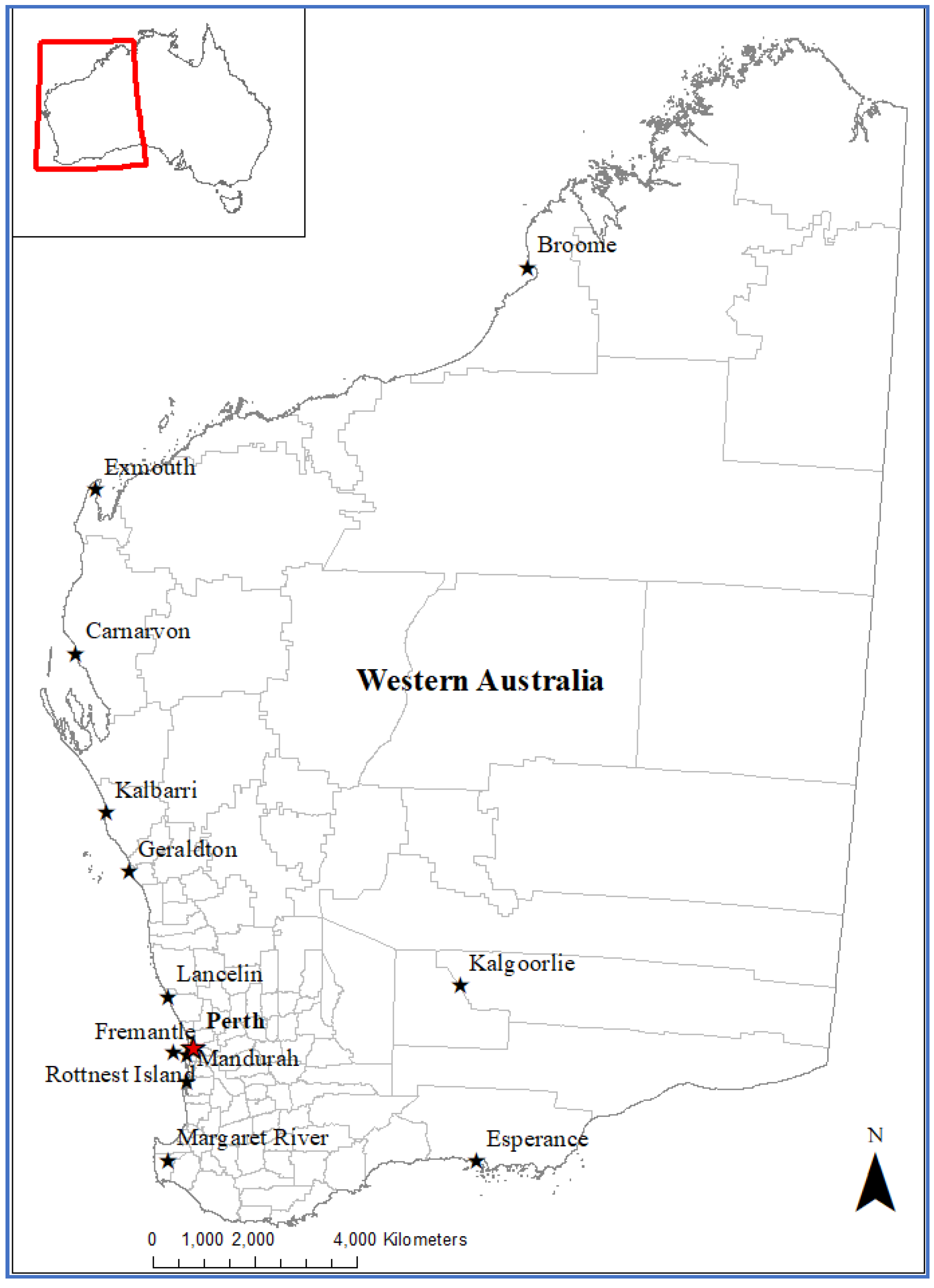
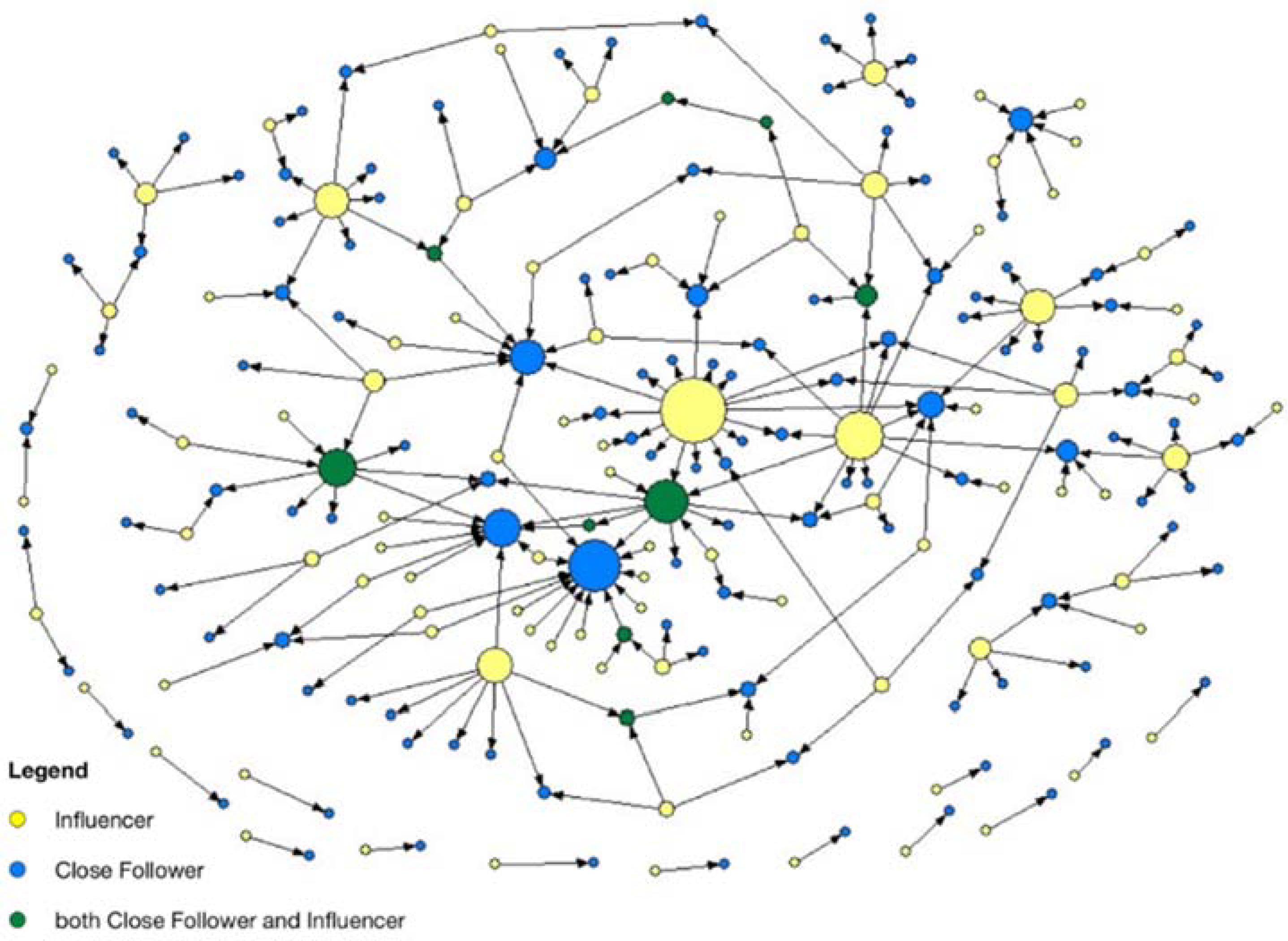
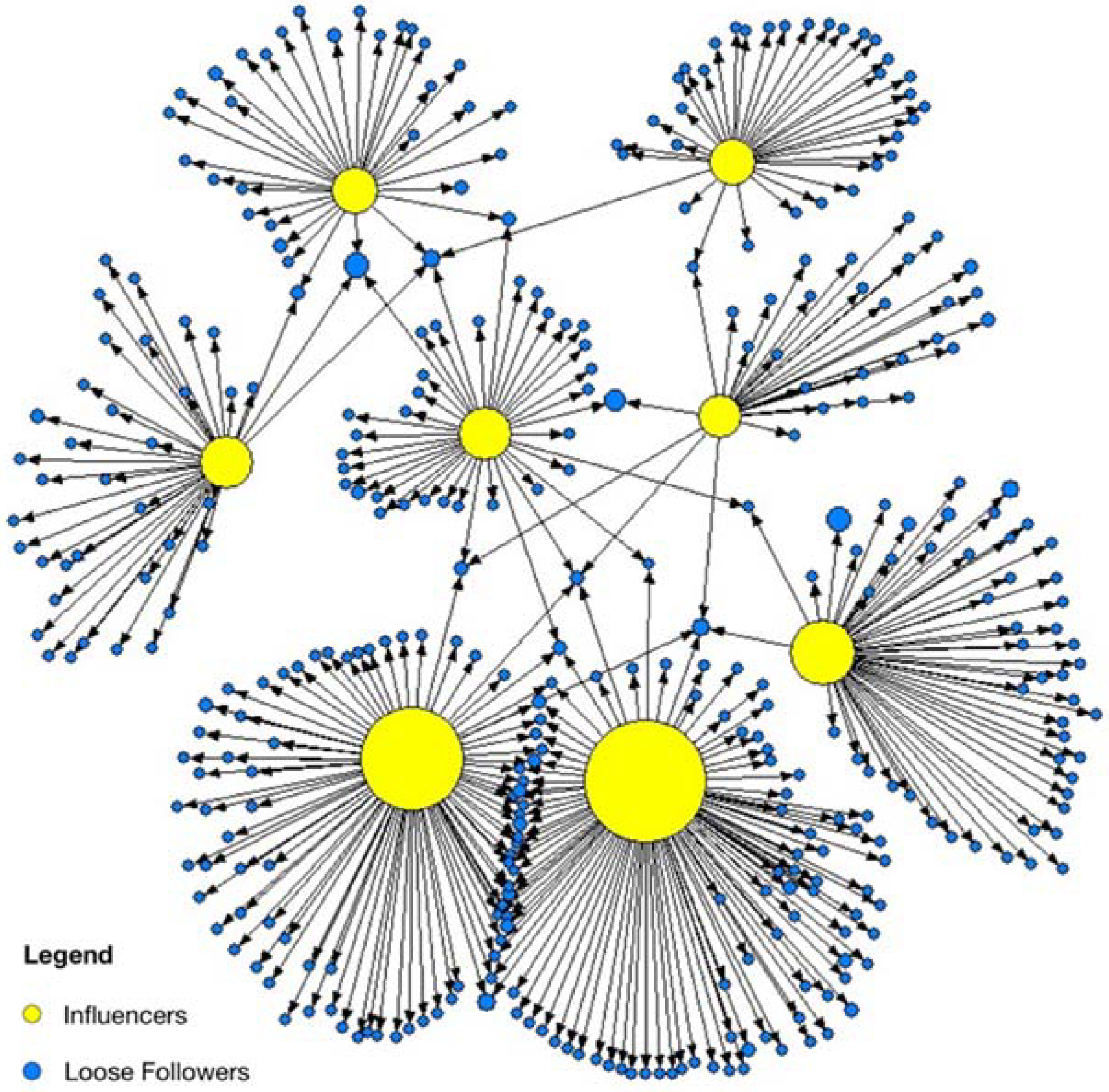
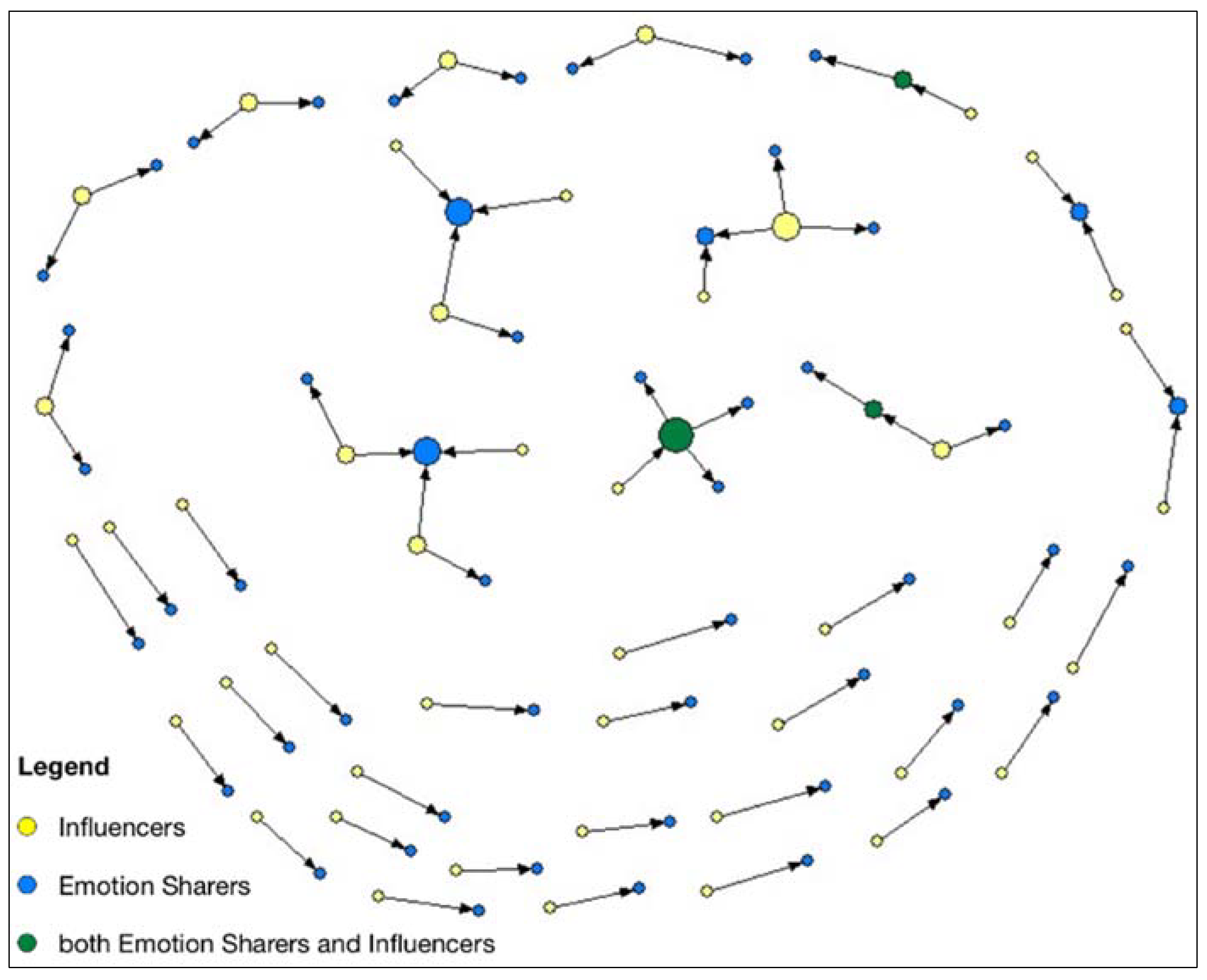
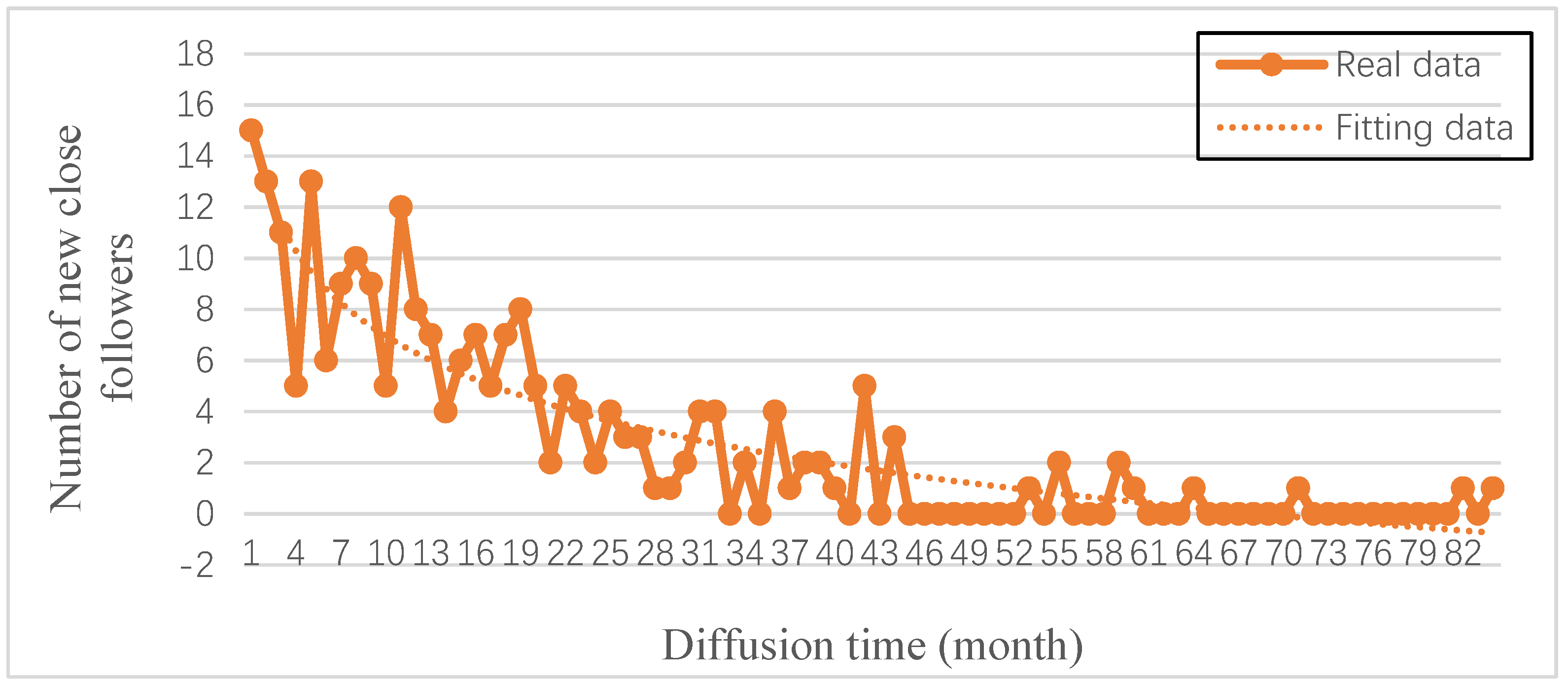
| Type of Diffusion Process | No. of Diffusion Links | No. of Influencers | No. of Close Followers | No. of Loose Followers | No. of Emotion Sharers | |
|---|---|---|---|---|---|---|
| Expansion Diffusion (close following) | 229 | 100 | 133 | / | / | |
| Contagious Diffusion | Loose following | 1425 | 198 | / | 1141 | |
| Emotion sharing | 65 | 49 | / | / | 55 | |
| Network | |||
|---|---|---|---|
| Close Following | Loose Following | Emotion Sharing | |
| Number of Nodes | 224 | 1,339 | 101 |
| Number of Edges | 229 | 1,425 | 65 |
| Average degree | 2.027 | 2.128 | 1.228 |
| Average shortest path | 1.204 | 1 | 1.075 |
| Network centralisation | 0.072 | 0.077 | 0.0283 |
| Year (No. of New Trip Diaries) | The Number of New Close Followers since Trip Diaries have Been Posted | Total New Close Followers | ||||||||
|---|---|---|---|---|---|---|---|---|---|---|
| Year 0 | Year 1 | Year 2 | Year 3 | Year 4 | Year 5 | Year 6 | Year 7 | Year 8 | ||
| (1–365 days) | (366–730) | (731–1095) | (1096–1460) | (1461–1825) | (1826–2190) | (2191–2555) | (2556–2920) | (2920–3285) | ||
| 2009 (trip diary 2) | 0 | 0 | 1 | 1 | 2 | 1 | 2 | 1 | 0 * | 8 |
| 2010 (trip diary 2) | 0 | 0 | 0 | 1 | 2 | 0 | 0 | 0 * | 3 | |
| 2011 (trip diary 3) | 1 | 4 | 9 | 1 | 2 | 1 | 0 * | 18 | ||
| 2012 (trip diary 7) | 3 | 8 | 3 | 2 | 0 | 0 * | 16 | |||
| 2013 (trip diary 12) | 18 | 6 | 3 | 4 | 0 * | 31 | ||||
| 2014 (trip diary 14) | 15 | 10 | 5 | 4 * | 34 | |||||
| 2015 (trip diary 14) | 10 | 7 | 2 * | 19 | ||||||
| 2016 (trip diary 32) | 29 | 9 * | 38 | |||||||
| 2017 (trip diary 17) | 13 * | 13 | ||||||||
| ZIP Model (Diffusion Effects) | |||
|---|---|---|---|
| Poisson Regression Model Part | Zero-Inflation Model | ||
| Parameter | Estimate (SE) | Parameter | Estimate (SE) |
| (Intercept) | −3.9193 (1.94 × 10−5) *** | (Intercept) | 3.0704 (0.0134) * |
| Save | 0.0055 (2.01 × 10−9) *** | save | −0.0366 (0.0017) ** |
| Placing on the top | 0.0012 (0.015) * | Ln_duration | −0.4085 (0.0304) * |
| Rank | 0.0177 (0.0143) * | ||
| Ln_duration | 0.4564 (9.60 × 10−6) *** | ||
| Ln_picture | 0.2215 (0.0063) ** | ||
| Log-likelihood | −351.4 on 12 Df | ||
| chi-squared test | 1.417239 × 10−48 (df = 12) | ||
| Zero observations | 157 | ||
© 2020 by the authors. Licensee MDPI, Basel, Switzerland. This article is an open access article distributed under the terms and conditions of the Creative Commons Attribution (CC BY) license (http://creativecommons.org/licenses/by/4.0/).
Share and Cite
Liu, T.; Xia, J.; Crowe-Delaney, L. Tourism Information Diffusion through SNSs: A Theoretical Investigation. Sustainability 2020, 12, 1731. https://doi.org/10.3390/su12051731
Liu T, Xia J, Crowe-Delaney L. Tourism Information Diffusion through SNSs: A Theoretical Investigation. Sustainability. 2020; 12(5):1731. https://doi.org/10.3390/su12051731
Chicago/Turabian StyleLiu, Ting, Jianhong Xia, and Lesley Crowe-Delaney. 2020. "Tourism Information Diffusion through SNSs: A Theoretical Investigation" Sustainability 12, no. 5: 1731. https://doi.org/10.3390/su12051731
APA StyleLiu, T., Xia, J., & Crowe-Delaney, L. (2020). Tourism Information Diffusion through SNSs: A Theoretical Investigation. Sustainability, 12(5), 1731. https://doi.org/10.3390/su12051731







